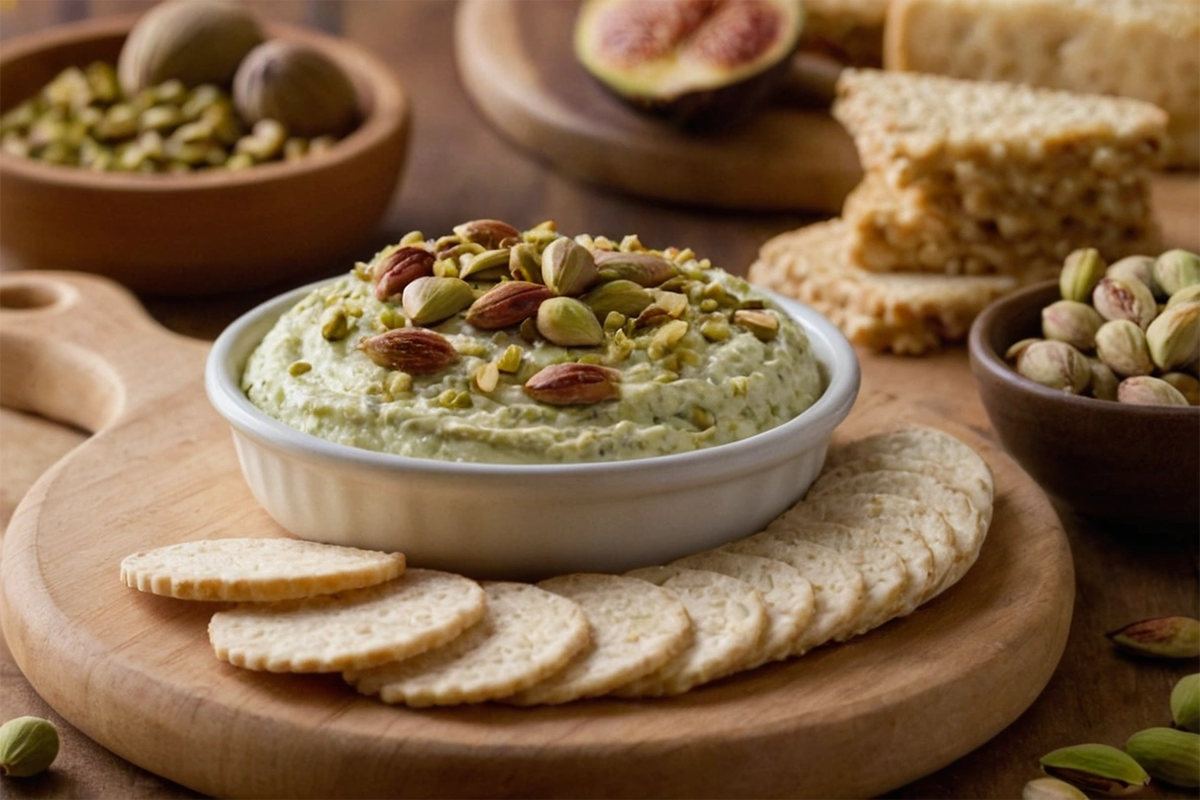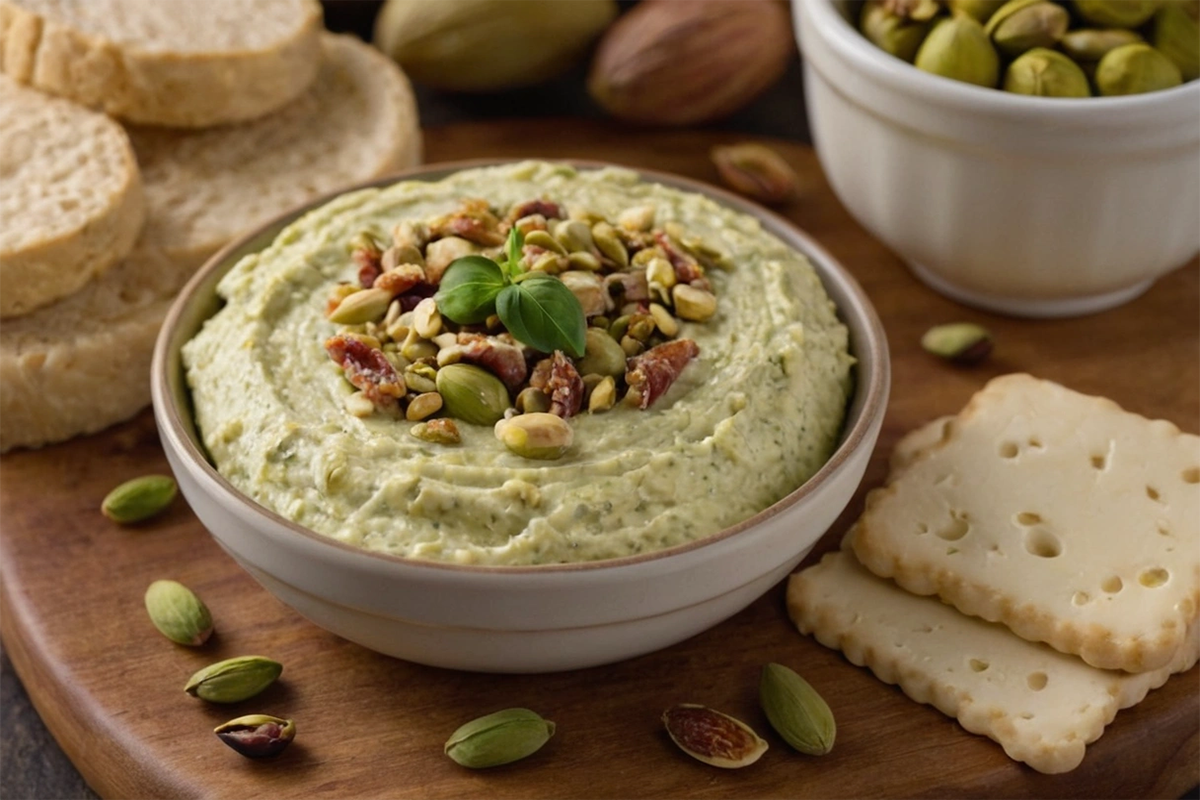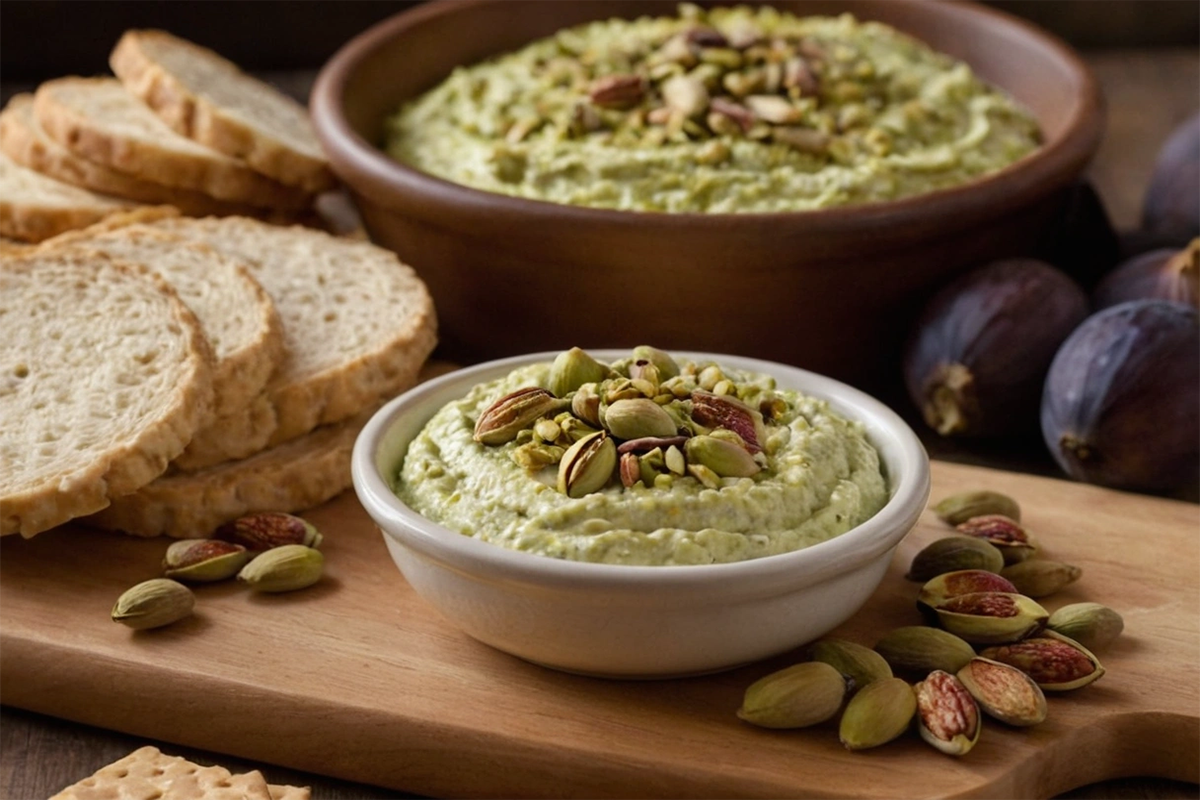This cheese is an exquisite and somewhat unique variety that blends the rich, nutty flavor of pistachios with a creamy, melt-in-your-mouth texture. Whether you’re a fan of artisan cheeses or you simply want to experiment with new flavors, pistachio cheese offers a distinct experience that sets it apart from more common cheeses.
In this article, we’ll explore the taste profile of this unique cheese, how it’s made, and the many ways you can use it in your cooking. We’ll also dive into different variations, answer some frequently asked questions, and discuss where you can purchase or make this gourmet delight. If you’re interested in trying other unique cheeses, you might also want to check out the article on Pistachio Cheesecake or learn about how to incorporate Broccoli Crunch Salad into your meals.
What Is Pistachio Cheese?
Pistachio cheese comes in two main types: vegan and dairy-based. Cooks make vegan pistachio cheese using ground pistachios, nutritional yeast, and a few simple ingredients. On the other hand, the dairy-based version blends pistachios into traditional cheeses like cream cheese, ricotta, or mascarpone.
- Vegan Pistachio Cheese: Vegan varieties of this nutty cheese are creamy, rich, and full of flavor, making them great for those avoiding dairy.
- Dairy-Based Pistachio Cheese: In this version, cooks mix cheeses like cream cheese or ricotta with ground pistachios to create a smooth, nutty-flavored cheese with a creamy texture.
What Does Pistachio Cheese Taste Like?
This nut-based cheese is known for its rich, slightly sweet, and earthy flavor. Depending on the recipe, it can be more savory, creamy, or sweet, but the pistachio taste always stands out.
- Nutty and Earthy: Pistachios have a strong, earthy taste, which is the main flavor in pistachio cheese.
- Mild Sweetness: Pistachios naturally have a bit of sweetness, especially in vegan versions. This mild sweetness works well in both savory and sweet dishes.
- Creamy Texture: Whether it’s dairy or vegan, pistachio cheese is usually creamy and spreadable, making it perfect for dipping or spreading on bread.
How Does It Compare to Other Cheeses?
Pistachio cheese stands out among other cheeses for its distinct nutty flavor. Compared to sharper options like blue cheese or cheddar, this variety has a milder taste. It’s often compared to cashew cheese or almond cheese in vegan circles, though pistachios lend a richer and more buttery taste compared to other nuts.
It also shares some similarities with ricotta or mascarpone in its creamy texture, particularly when made with dairy. If you love soft cheeses or nut-based vegan cheeses, pistachio cheese is definitely one to try.
The Origin of Pistachio Cheese
While pistachios have long been a part of Mediterranean and Middle Eastern cuisine, pistachio cheese is a relatively modern innovation. The idea of infusing traditional cheeses with pistachios or creating a pistachio-based vegan cheese came about as people sought to incorporate more plant-based foods into their diets and experiment with new flavors.
It has become especially popular in gourmet circles, with chefs experimenting with pistachio cheese in both savory and sweet dishes. Pistachios themselves have been cultivated for thousands of years, but their recent role in cheese-making is a testament to their versatility and enduring appeal.
How This Nutty Cheese Is Made
Making pistachio cheese at home is relatively simple, especially if you’re opting for the vegan version. Here’s how you can make your own pistachio cheese:
Vegan Pistachio Cheese Recipe
- Ingredients:
- 1 cup shelled pistachios (soaked for at least 4 hours)
- 2 tablespoons lemon juice (to add a tangy brightness)
- 1 tablespoon nutritional yeast (this gives the cheese a savory, umami flavor)
- 1 clove garlic (garlic adds a nice kick)
- Salt and pepper to taste
- 1-2 tablespoons water (to adjust the consistency)
- Optional: Fresh herbs like basil, parsley, or dill to enhance flavor and give the cheese a green, herbal edge.
- Directions:
- Step 1: Soak the pistachios in water for at least four hours, or overnight if possible. This softens the nuts and makes them easier to blend into a smooth consistency.
- Step 2: Drain the pistachios and add them to a high-powered blender or food processor. Add the lemon juice, nutritional yeast, garlic, salt, and pepper.
- Step 3: Blend the mixture until smooth, scraping down the sides as necessary. Slowly add water, a tablespoon at a time, until you reach the desired creamy consistency.
- Step 4: Taste the cheese and adjust the seasoning with more salt or lemon juice if needed. For a more herbaceous flavor, add freshly chopped herbs like dill or parsley and blend until smooth.
- Step 5: Transfer the cheese to a bowl or container and refrigerate for at least an hour to allow the flavors to meld and the texture to firm up.
Dairy-Based Pistachio Cheese Recipe
- Ingredients:
-
- 1 cup ricotta, mascarpone, or cream cheese (use a smooth, spreadable cheese as the base)
- ½ cup finely ground pistachios
- 1 tablespoon honey (optional for a touch of sweetness)
- Salt to taste
- Optional: 1 teaspoon lemon zest (for a light citrus zing) and a pinch of cinnamon for added warmth
-
- Directions:
-
- Step 1: Finely grind the pistachios using a blender or food processor. You want them to be finely ground but not turned into a paste.
- Step 2: In a mixing bowl, combine the ground pistachios with the ricotta or cream cheese. Stir until fully incorporated.
- Step 3: Add the honey, lemon zest, and a pinch of salt to balance the flavors. Stir until well-mixed.
- Step 4: For a smoother consistency, you can use an electric mixer to blend the ingredients further. Taste and adjust the seasoning as necessary.
- Step 5: Chill the cheese for at least one hour in the refrigerator before serving. The flavors will develop as it sits.
-
Popular Uses for Pistachio Cheese
Pistachio cheese is incredibly versatile and can be used in a variety of culinary applications. Some popular ways to enjoy this unique cheese include:
- Salads: Add pistachio cheese to a fresh, green salad for a creamy, nutty flavor boost. It pairs particularly well with arugula, spinach, and fruit like pears or apples.
- Cheese Platters: Include pistachio cheese on your next cheese platter alongside other gourmet options. It goes well with figs, honey, and crackers.
- Pasta: Stir this cheese into your favorite pasta dish for a rich, creamy texture. It complements pesto or other light sauces beautifully.
- Desserts: Use the sweeter version of pistachio cheese to top off desserts like cakes or pastries. The mild sweetness of the cheese can enhance the flavors of fruit-based desserts.
How Pistachio Cheese Fits Into Different Cuisines
Given its Mediterranean origins, pistachio cheese is often used in dishes from that region. However, it has spread into many different cuisines due to its versatility.
Mediterranean Cuisine:
Pistachio cheese is often used in Middle Eastern and Mediterranean dishes, particularly as part of mezze platters or as a topping for flatbreads. Pair it with olives, hummus, and pita bread for a traditional Mediterranean meal.
Italian Cuisine:
Italians use pistachio-infused cheeses like ricotta or mascarpone in pasta dishes, risottos, and desserts. It adds a nutty richness that enhances the flavors of tomatoes, garlic, and basil.
Global Fusion:
Chefs around the world are trying new ways to use pistachio cheese. From adding it to sushi to using it in fusion tacos, its unique flavor helps it cross cultural boundaries.
Nutritional Benefits of Pistachio Cheese
Pistachio cheese, especially the vegan version, boasts an impressive nutritional profile:
- Protein: Pistachios are a good source of plant-based protein, which is particularly beneficial for vegans and vegetarians.
- Healthy Fats: Pistachio cheese is rich in monounsaturated fats, which are good for heart health.
- Vitamins: Pistachios provide essential vitamins, such as Vitamin B6, which supports brain health, and Vitamin E, which is great for skin health.
- Minerals: Magnesium, potassium, and calcium are also present in pistachios, adding to their nutritional benefits.
Frequently Asked Questions (FAQs)
Discover the Flavor Profile of Pistachio-Based Cheese
This nut-infused cheese has a rich, nutty flavor with hints of earthiness and mild sweetness. Its creamy texture makes it perfect for spreading on bread, crackers, or using as a dip. Whether it’s the vegan or dairy version, the taste can range from rich and buttery (for dairy options) to more nutty and slightly sweet (for vegan alternatives). The pistachio essence is strong but not overwhelming, making it suitable for many dishes.
Can pistachio cheese be used in desserts?
Yes! This nutty cheese can enhance sweet treats like cheesecakes, pastries, or even fruit parfaits. When made sweeter with honey or maple syrup, it becomes an elegant topping for cakes, muffins, or tarts. It also pairs well with Mediterranean-inspired desserts, such as those featuring dates, figs, or citrus fruits.
Is pistachio cheese good for lactose-intolerant people?
If you choose the vegan version, it’s completely free of lactose and safe for those who are lactose intolerant. However, dairy-based versions do contain lactose, so you need to select the appropriate option based on your dietary needs. Many vegan recipes are also suitable for people avoiding dairy for health or ethical reasons.
How long does homemade pistachio cheese last?
Homemade versions, whether vegan or dairy-based, can stay fresh for up to 5 days in the fridge when stored in an airtight container. To maintain freshness, be sure it’s tightly sealed and refrigerated promptly. You can also freeze it for longer storage, though the texture may change slightly after thawing.
Can I use roasted pistachios instead of raw?
Yes, you can use roasted pistachios, but roasting makes the nutty flavor stronger and may slightly change the cheese’s texture. For a deeper, more toasted taste, roasted pistachios are a good choice, especially if you like a richer flavor. Raw pistachios, on the other hand, give a lighter, more natural pistachio taste, which is great for milder dishes.
Conclusion
Pistachio cheese blends the nutty, earthy taste of pistachios with a creamy texture, making it great for many different dishes. Whether you pick the vegan or dairy-based version, this cheese is versatile and works well in everything from salads to desserts.
With its rich nutrients and unique flavor, pistachio cheese is quickly becoming a favorite among food lovers. Whether you’re adding it to a Mediterranean dish or trying it in gourmet recipes, this cheese stands out with its nutty taste and smooth, creamy texture. For more information on the culinary uses of pistachios, you can read this detailed article on Pistachio .



